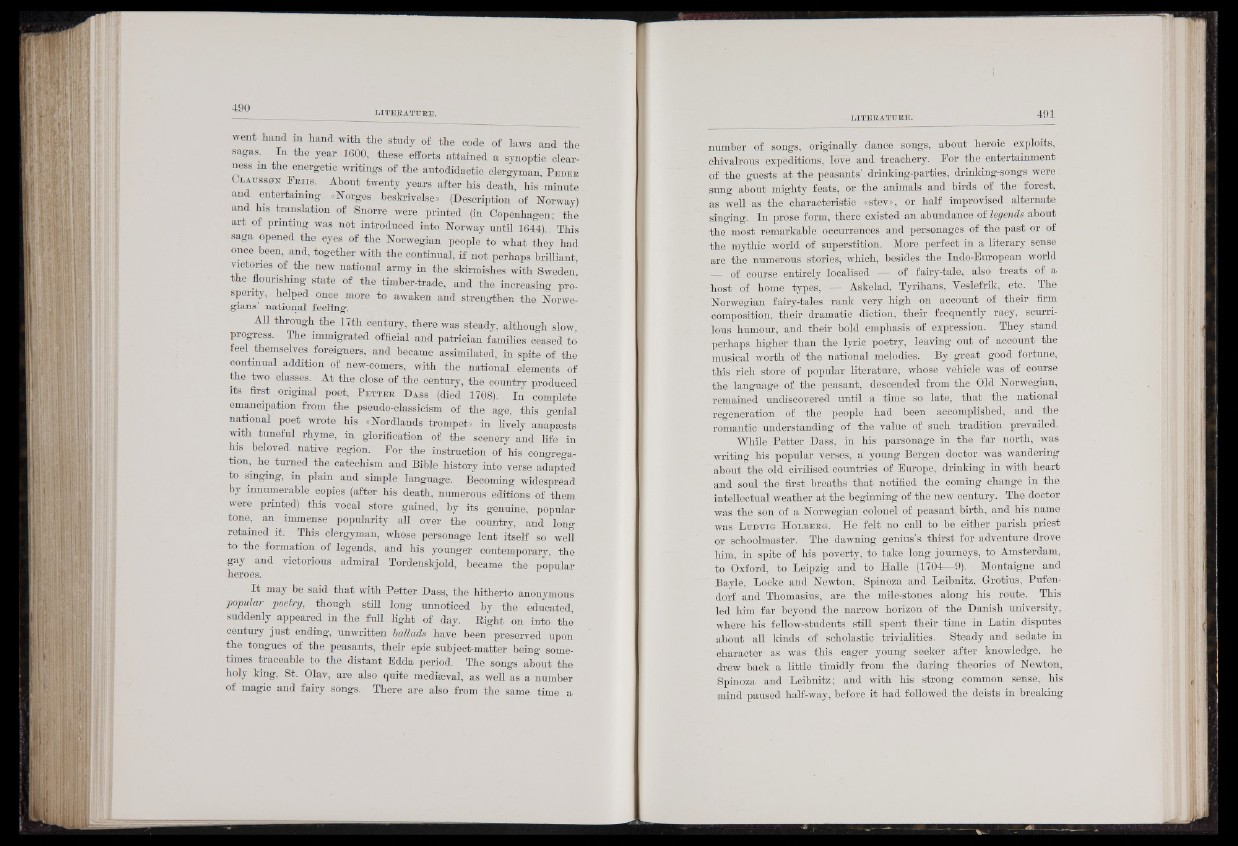
went hand in hand with the study of the code of laws and the
sagas. In the year 1600, these efforts attained a synoptic clearness
m the energetic writings of the autodidactic clergyman, P e d e r
O l a u s s é w F r i i s . About twenty years after his death, his minute
and entertaining «Norges beskrivelse» (Description of Norway)
and his translation of Snorre were printed (in Copenhagen; the
art of printing was not introduced into Norway until 1644). This
saga opened the eyes of the Norwegian people to what they had
once been, and, together with the continual, if not perhaps brilliant
victories of the new national army in the skirmishes with Sweden’
the flourishing state of the timber-trade, and the increasing, prosperi^,
helped once more to awaken and strengthen the Norwegians’
national feeling.
All through the 17th century, there was steady, although slow
progress. The immigrated official and patrician families ceased to
eel themselves foreigners, and became assimilated, in spite of the
continual addition of new-comers, with the national elements of
the two classes. At the close of the century, the country produced
its first ..original poet, P e t t e r D a s s (died 1708). In complete
emancipation from the pseudo-classicism of the age, this genial
national poet wrote his «Nordlands trompet» in lively anapsests
with tuneful rhyme, in glorification of the scenery and life in
Ms beloved native region. For the instruction of Ms congregation,
he turned the catecMsm and Bible history into verse adapted
to fringing, in plain and simple language. Becoming widespread
by innumerable copies (after his death, numerous editions of them
were prrnted) this vocal store gamed, by its genuine, popular
tone, an immense popularity all over the country, and long
retained it. This clergyman, whose personage lent itself so well
to the formation of legends, and his younger contemporary, the
gay and victorious admiral Tordenskjold, became the popular
heroes.
I t may be said that with Petter Dass, the hitherto anonymous
popular poetry, though still long unnoticed by the educated
suddenly appeared in the full light of day. Eight on into thè
century just ending, unwritten ballads have been preserved upon
the tongues of the peasants, their epic subject-matter being sometimes
traceable to the distant Edda period. The songs about the
holy king, St. Olav, are also quite mediaeval, as well as a number
of magic and fairy songs. There are also from the same time a
number of songs, originally dance songs, about heroic exploits,
chivalrous expeditions, love and treachery. For the entertainment
of the guests at the peasants’ drinking-parties, drinking-songs were
sung about mighty feats, or the animals and birds of the forest,
as well as the characteristic «stev», or half improvised alternate
singing. In prose form, there existed an abundance of legends about
the most remarkable occurrences and personages of the past or of
the mythic world of superstition. More perfect in a literary sense
are the numerous stories, which, besides the Indo-European world
_ of course entirely localised SSj o f ' fairy-tale, also treats of a
host of home types, Askelad, Tyrihans, Yeslefrik, etc. The
Norwegian fairy-tales' rank -very Mgh on account of their firm
composition, their dramatic diction, their frequently racy, scurrilous
humour, and their bold emphasis of expression. They stand
perhaps higher than the lyric poetry, leaving out of account the
musical worth of the national melodies. By great good fortune,
this rich store of popular literature, whose vehicle was of course
the language of the peasant, descended from the Old Norwegian,
remained undiscovered until a time so late, that the national
regeneration of the people had been accomplished, and the
romantic understanding of the value of such tradition prevailed.
WMle Petter Dass, in his parsonage in the far north, was
writing his popular verses, a young Bergen doctor was wandering
about the old civilised countries of Europe, drinking in with heart
and soul the first breaths that notified the coming change in the
intellectual weather at the beginning of the new century. The doctor
was the son of a Norwegian colonel of peasant^ birth, and his name
was L u d v ig H o l b e b g . He felt no call to be either parish priest
or schoolmaster. The dawning genius’s thirst for adventure drove
Mm, in spite of Ms poverty, to take long journeys, to Amsterdam,
to Oxford, to Leipzig and to Halle (1704—9). Montaigne and
Bayle, Locke and Newton, Spinoza and Leibnitz, Grotius, Pufen-
dorf and Thomasius, are the mile-stones along his route. This
led him far beyond the narrow horizon of the DaMsh university,
where his fellow-students still spent their time in Latin disputes
about all kinds of scholastic trivialities. Steady and sedate in
character as was this eager young seeker after knowledge, he
drew back a little timidly from the daring theories of Newton,
Spinoza and Leibnitz; and with his' strong common sense, Ms
mind paused half-way, before it had followed the deists in breaHng